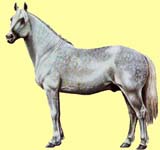|
|
Irish Draught |
|
|
|
Irish Draught |
|
 The exact origins of the Irish Draught are uncertain, but some believe that it is likely to have descended from the
Connemara, having some
Clydesdale influence in the 19th Century. It is probable that the indigenous stock of Ireland was upgraded by contributions from the
Spanish Horse. Heavy European horses, mostly French and
Flemish, were imported into Ireland from the time of the Anglo-Norman invasion of 1172, likely having a contribution to the size and character of the Irish Draught. These strong mares were improved with contributions of more eastern and Spanish, or
Andalusian, blood, developing horses of a meso-brachymorphic type. The offspring of these crosses have been used for every sort of farming purpose, in harness and under saddle, on the small Irish farms. The very strictly maintained Stud Book goes back to 1917, and is of national importance in Ireland.
The exact origins of the Irish Draught are uncertain, but some believe that it is likely to have descended from the
Connemara, having some
Clydesdale influence in the 19th Century. It is probable that the indigenous stock of Ireland was upgraded by contributions from the
Spanish Horse. Heavy European horses, mostly French and
Flemish, were imported into Ireland from the time of the Anglo-Norman invasion of 1172, likely having a contribution to the size and character of the Irish Draught. These strong mares were improved with contributions of more eastern and Spanish, or
Andalusian, blood, developing horses of a meso-brachymorphic type. The offspring of these crosses have been used for every sort of farming purpose, in harness and under saddle, on the small Irish farms. The very strictly maintained Stud Book goes back to 1917, and is of national importance in Ireland.
The bone, substance and size of the Irish Draught has been produced as a result of the rich limestone pastures and mild climate of the area, and the Irishman's innate love of hunting has resulted in it developing an uncanny ability to maneuver across even the most fearsome obstacles. The Irish Draughts also make good natural jumpers, even though they are small in size and build, and they can be found at any sort of work.
An Irish Draught mare, often called "the horse of the countryside," crossed with an English Thoroughbred stallion produces the Irish Hunter. The Irish Hunter is a first-rate sporting horse, and it is one of the best show jumpers in the world. This cross gives quality, added scope and speed to the offspring without detracting from the Irish Draught's inherited hunting abilities. These offspring are strong, well-grown animals which are increasingly making a mark in show-ring classes.
The Irish Draught stands 15 to 17 hands high at the withers, the average about 16 hands. The coat color may be brown, bay, grey or chestnut. Dapple grey and all solid colors occur within the breed. It has a well-proportioned head, though somewhat small in relation to the size of its body, with a straight profile, broad forehead and with the ears pricked up. It is intelligent and has a decidedly knowing look about it. The generous eyes have an honest expression, like that of a workman. Its neck is of average length and breadth, and the withers are quite pronounced. The naturally deep chest is wide, and the abdomen is drawn in. Its shoulder is nicely sloping, massive and powerful. The shoulders of the older type tended to be upright and the neck short, but these failings have been eradicated in the modern horse. Because of this improvement, the forelegs are well placed giving it a longer stride.
Its limbs are massive with good flat bone, and its solid legs are well-muscled, with broad tough joints, solid cannons and pasterns, and a broad, round foot. There is slight feathering or no feathering at the extremities. It has a long, straight back, and a fairly sloping croup. Sometimes the back may tend to be a little too long and the quarters too sloping, but most horses have an overall structure which is one of splendid strength. The great strength in the quarters is a hallmark of this breed's jumping abilities. It's action is straight, level and balanced. Though not exaggerated, the Irish Draught is athletic and covers the ground well. The tail is well set-on, full and flowing. Its body is deep and the coat is not coarse, but fine. It has a distinctly oval ribcage, and there should be no slab-sidedness.
A horse with a quiet, but dynamic temperament, the Irish Draught is well-suited to medium-heavy draft and farm work, and makes a good riding horse. This natural jumper is agile, very athletic and bold. Most stallions which are registered with the Irish Draught Horse Society regularly take part in hunts and in jumping competitions. This temperamentally equable breed is cooperative and economical to keep.
For more information on the Irish Draught, visit:

|
© 1997-2007
NW Breyer Horse Club & Refiner of Gold Creations Equinealities in place since 1997, Section in place 2001, Updated 3/13/2007 |



|
| ||

|
|||||